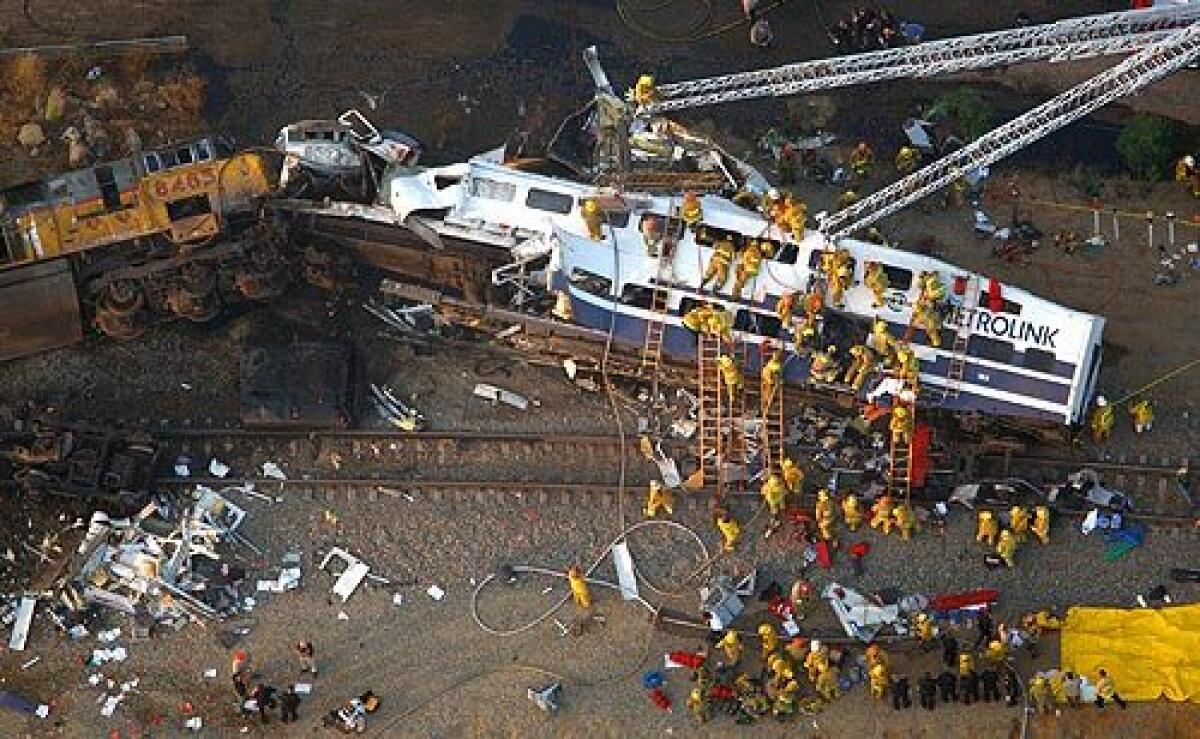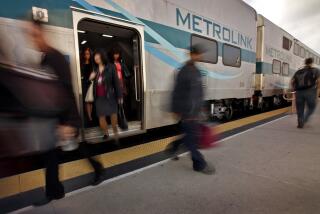‘Total destruction’: At least 17 die in head-on Metrolink crash

- Share via
Rescue teams worked frantically into this morning after a Metrolink passenger train carrying 225 people collided Friday with a Union Pacific freight train on a sharp curve in Chatsworth, killing at least 17 people and leaving more than 135 injured. It was one of the worst train crashes in Southern California history and Metrolink officials said they could not explain why warning systems failed to prevent such a catastrophic collision.
About 250 fire department personnel and 200 police officers were on the scene before dawn Saturday, the Associated Press reported.
Hours after the crash Friday afternoon, Los Angeles City Fire Capt. John Virant, his face glistening with sweat, described the scene as “total destruction . . . chaos.” “They are in there removing dead bodies that are lying on top of survivors,” Virant said. In the front train carriage, he said, “it was as if somebody had just taken all the seats and thrown them in there.”
Metrolink’s Train 111, en route from Los Angeles’ Union Station to Moorpark, had just left the Chatsworth station when the crash occurred at 4:23 p.m. on a 45-degree bend. The engine of the freight train embedded itself in the front Metrolink carriage as both trains derailed, sending one of the train’s three cars full of homebound commuters keeling onto its side. An earsplitting concussion rocked nearby homes, followed by screams from those aboard.
“I saw it coming,” said Eric Forbes, 56, an administrator at Cal State Northridge who was riding in the second or third car of the Metrolink train when he glanced out the window to see the freight train bearing down. He spoke later at a nearby triage center, his raspy voice swelling with emotion as he was wheeled on a stretcher to an ambulance.
“There was no time to stop,” he said. “The next thing I knew I was in a seat in front of me. It was horrible.”
Metrolink spokeswoman Denise Tyrell said officials did not yet know how the accident occurred. “Obviously two trains are not supposed to be at the same place at the same time.”
Tom Dinger, an engineer who retired last year from Amtrak after a 43-year railroad career, said normal procedure called for the northbound passenger train to pull into a rail siding at the Chatsworth station to allow the southbound freight train to pass. He said he had steered through that stretch of track hundreds of times. Between Chatsworth and Simi Valley there is only one set of tracks because of narrow tunnels that trains use to go through the Santa Susana Pass.
He said he talked by telephone with Metrolink conductor Bob Hildebrand, who was injured. Hildebrand told him he was in the rear club car when the trains collided. “He told me they were going 40 mph and came to a dead stop,” Dinger said.
Metrolink said the train’s engineer, whom it did not identify, died in the crash. There was no word on the fate of the Union Pacific crew.
Joelle Ouellet, 38, said she was a few hundred feet away, turning around her horse on a nearby ranch, when the trains collided. “I heard a huge crash,” she said. “Then I saw a fireball. I ran over there and there were people lying all over the hill.”
As the rescue effort swung into full gear, yellow-clad firefighters clambered over the train cars and peeled back the roof of one car to gain entry to the passenger compartment.
“Victims are on top of victims,” Los Angeles Fire Chief Douglas Barry said after surveying the scene. “Metal and debris is all tangled together. It’s a difficult situation.”
At one point, a Los Angeles police officer went to the house of Jim Halty, who lives near the tracks. They had a brief conversation and the officer left with an American flag.
A short time later, alongside the wreckage, scores of uniformed Los Angeles Police Department officers formed two lines in a makeshift formation waiting for rescue crews to extract the body of an LAPD officer on her way home from work.
With somber faces and hands clasped in front of them, they waited in silence, many peering up at the hole cut in the twisted metal of the front train car, from which firefighters were pulling bodies.
Shortly after sunset, Los Angeles Mayor Antonio Villaraigosa spoke to reporters at the scene, saying: “We don’t know the number of people still trapped inside. We don’t know what condition they’re in. There are people trapped in there dead and alive -- they know that some are dead.”
He said at least 10 fatalities had been confirmed by the coroner’s office and that the number of injured “is hard to estimate at this point. We know that dozens of people have been injured, probably over 100.” The death toll was later raised to at least 15.
Villaraigosa also said he was heartbroken by what he called “the devastation, the carnage,” adding, “I haven’t seen anything like it.”
There were three passenger cars on the Metrolink train, each capable of carrying up to 155 people.
Injured passengers, some of them in critical condition, were taken to several nearby hospitals, including Providence Holy Cross Medical Center, Huntington Hospital, Los Angeles County-USC Medical Center, UCLA Medical Center and Northridge Hospital Medical Center. The triage center was established at the Chatsworth Hills Academy, just yards from the crash site.
Three hours after the crash, as darkness fell, several victims were still being assessed, lying under thick red blankets to keep them warm on the cold grass. Medical personnel wheeled victims on stretchers to an armada of ambulances. One man walked slowly with bandages on his nose and face, an IV bag held aloft by a firefighter.
Another woman was whisked off with an oxygen mask over her mouth and nose, with her purse tucked in against the rail of the stretcher.
All wore the color-coded tags that indicated the severity of their injuries and their names. A medevac helicopter lifted off, the noise drowning out the shouts of personnel and then leaving relative silence in its place. Ambulance lights bathed the scene in the bright flashes of their red and white emergency lights.
Metrolink trains have been involved in several serious wrecks in recent years, the worst of them a crash with an SUV near Glendale that killed 11 people in 2005. Friday’s crash more closely resembled one in Placentia in 2002, in which three people died and more than 260 were injured when a Burlington Northern & Santa Fe freight train plowed into a double-decker Metrolink passenger train.
Federal investigators blamed that crash on an inattentive Burlington Northern crew that missed a warning signal as well as on the lack of an automatic braking system on the freight train.
The worst train wreck in Los Angeles history occurred on Jan. 22, 1956, when a Santa Fe train en route from Los Angeles to San Diego lurched off a curve near the Los Angeles River, killing 30 people and injuring 130.
Professor James Moore, the director of the transportation engineering program at USC, said he was surprised by the collision because a great deal of money has been invested in technology designed to prevent such head-on crashes.
“This is quite different from the Glendale crash. In that one, there was a Jeep Cherokee on the tracks that was not supposed to be there,” Moore said. “These trains were rolling assets that were subject to active management, and the system is designed to make sure they do not occupy the same place at the same time.”
Moore said he suspected that the “geometry” of the site -- referring to the severe angle of the bend -- may have played a role.
Jeremy Schneider, a 36-year-old paralegal from Simi Valley, was sitting next to a friend after the train pulled out of the Chatsworth station. “We were talking and all of a sudden -- bam!”
Schneider said he assessed the situation, saw that his friend “had a massive gash on her head,” and began moving through the car, seeing how he could help. “I see a fire, the train’s on fire,” he said. “A lot of people can’t move. . . . One guy was yelling all the time, ‘Please get me out of here.’ He was pinned.”
Schneider said he had a friend who was injured in a previous Metrolink crash. “I think it’s an outrage that Metrolink has let this happen again,” he said. “How do you hit a freight train head on in broad daylight? How could this happen?”
More to Read
Sign up for Essential California
The most important California stories and recommendations in your inbox every morning.
You may occasionally receive promotional content from the Los Angeles Times.












